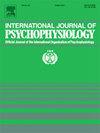自主神经对心脏防御反应的注意调节的贡献。
IF 2.6
3区 心理学
Q3 NEUROSCIENCES
引用次数: 0
摘要
心脏防御反应对厌恶听觉刺激的特征是两个加速/减速心率成分。第一个组成部分归因于有助于发现和处理潜在威胁的注意过程,第二个组成部分归因于保护行动。本研究探讨了注意对心脏防御反应的调节以及自主心脏控制在其中的作用。对60名健康受试者进行心脏防御反应,同时进行心电图、阻抗心动图和连续血压记录。射血前期表现为交感神经、副交感神经、心率变异性和收缩压控制。一半的受试者在噪声刺激后执行视觉搜索任务;另一半则在没有任何后续任务的情况下接受刺激。任务执行与防御反应的第二次心率加速/减速部分的增强有关。此外,在第二部分,有更大的收缩压下降。虽然弹射前期不受任务影响,但执行任务的受试者的心率变异性反应总体上较小。研究结果表明,副交感神经心脏控制介导了心脏防御反应的第一个加速/减速部分;交感神经和副交感神经机制是第二个组成部分。虽然交感神经控制不受注意要求的影响,但由于对外部注意的要求,心脏防御反应的增强可能与副交感神经戒断的增加有关。本文章由计算机程序翻译,如有差异,请以英文原文为准。
Autonomic contributions to attentional modulation of the cardiac defense response
The cardiac defense response to aversive auditory stimulation is characterized by two acceleration/deceleration heart rate components. The first component is ascribed to attentional processes that facilitate detection and processing of potential threat, and the second one to protective actions. This study investigated attentional modulation of the cardiac defense response and the role of autonomic cardiac control therein. In 60 healthy subjects, the cardiac defense response was elicited, while electrocardiography, impedance cardiography and continuous blood pressure recordings were accomplished. Pre-ejection period represented sympathetic, heart rate variability parasympathetic, and systolic blood pressure sympathetic and parasympathetic, control. Half of the subjects performed a visual search task following the noise stimulus; the other half was exposed to the stimulus without any subsequent task. Task execution was associated with potentiation of the second heart rate acceleration/deceleration component of the defense response. Moreover, there was a greater systolic blood pressure decline during the second component. While pre-ejection period was unaffected by the task, the heart rate variability response was smaller overall in subjects performing the task. The findings suggest mediation of the first acceleration/deceleration component of the cardiac defense response by parasympathetic cardiac control; sympathetic and parasympathetic mechanisms contribute to the second component. While sympathetic control was unaffected by attentional demands, the potentiation of the cardiac defense response due to demands on external attention may relate to increased parasympathetic withdrawal.
求助全文
通过发布文献求助,成功后即可免费获取论文全文。
去求助
来源期刊
CiteScore
5.40
自引率
10.00%
发文量
177
审稿时长
3-8 weeks
期刊介绍:
The International Journal of Psychophysiology is the official journal of the International Organization of Psychophysiology, and provides a respected forum for the publication of high quality original contributions on all aspects of psychophysiology. The journal is interdisciplinary and aims to integrate the neurosciences and behavioral sciences. Empirical, theoretical, and review articles are encouraged in the following areas:
• Cerebral psychophysiology: including functional brain mapping and neuroimaging with Event-Related Potentials (ERPs), Positron Emission Tomography (PET), Functional Magnetic Resonance Imaging (fMRI) and Electroencephalographic studies.
• Autonomic functions: including bilateral electrodermal activity, pupillometry and blood volume changes.
• Cardiovascular Psychophysiology:including studies of blood pressure, cardiac functioning and respiration.
• Somatic psychophysiology: including muscle activity, eye movements and eye blinks.

 求助内容:
求助内容: 应助结果提醒方式:
应助结果提醒方式:


